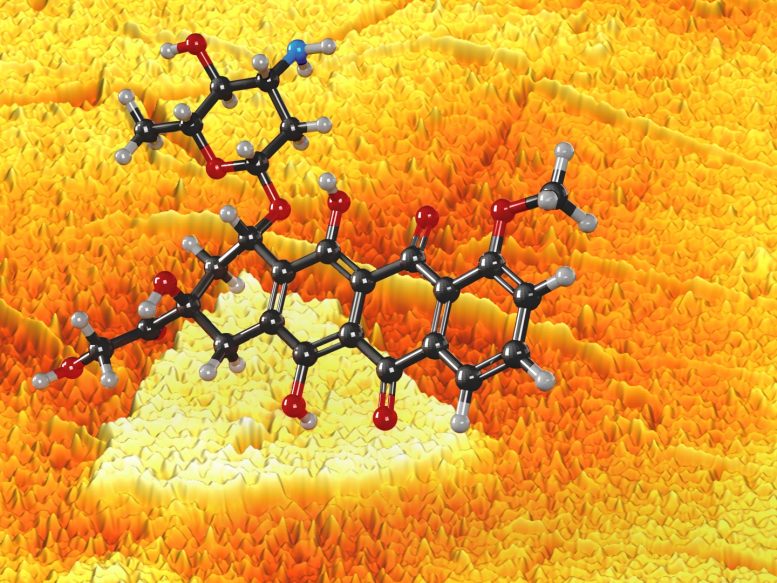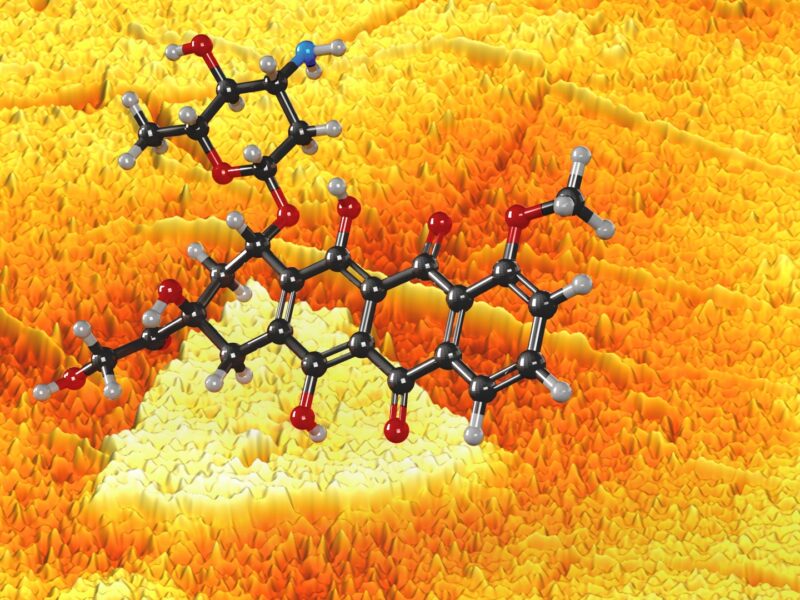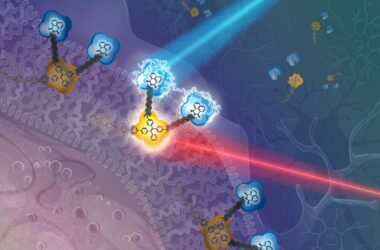
Une molécule de doxorubicine, un médicament contre le cancer (au premier plan), détectée à l’aide du biocapteur à hétérostructure verticale de Van der Waals (à l’arrière-plan). L’arrière-plan est une image de microscopie optique à balayage en champ proche (sSNOM) de l’hétérostructure. Le grand triangle est un îlot de MoS2 monocouche (environ 3,7 microns de large), le plus petit triangle est un îlot de MoOS partiellement oxydé, et l’ensemble de l’échantillon est recouvert de graphène monocouche, avec plusieurs rides clairement visibles sur la carte. La zone de graphène plus sombre correspond à la région de dopage de charge supplémentaire. Crédit : Elizabeth Flores-Gomez Murray/Jennifer McCann/Slava Rotkin, Penn state
Selon une équipe de chercheurs, une nouvelle et meilleure approche de la détection des non-uniformités dans les propriétés optiques des matériaux bidimensionnels pourrait potentiellement ouvrir la porte à de nouvelles utilisations de ces matériaux, comme la détection des drogues.
“Le Consortium de cristaux bidimensionnels (2DCC) est un leader mondial dans la recherche sur les matériaux bidimensionnels et mon laboratoire travaille souvent avec le 2DCC pour caractériser les nouveaux matériaux bidimensionnels”, a déclaré Slava V. Rotkin, professeur frontalier de sciences de l’ingénieur et de mécanique et membre du Materials Research Institute de Penn State. “Ces études présentent un défi de taille : Souvent, les propriétés optiques des matériaux en 2D ne sont pas uniformes dans l’espace. En outre, elles peuvent varier à une très petite échelle spatiale, jusqu’à un seul atom.”
Rotkin and other researchers were able to take one step toward a possible solution, which was outlined in ACS Nano. While Rotkin stresses they only gave a demonstration of the principle in the study, the solution they propose was used for van der Waals heterostructures which could enable sensors made with 2D materials, materials that are one to a few atoms thick.
Sensors can be developed that enable sensing of bio-, chemical and/or medical analytes of interest. Analytes are specific chemicals targeted for measurement or analysis. A good sensor detects these analytes with minimal sample preparation, in an abbreviated time frame, with low detection limits, and using samples containing substances other than the key analyte.
Identifying and understanding variability of properties in materials could be extremely important for applications of 2D materials as sensors. The sensor material typically can only interact with the analyte at the surface. Thus, the material’s surface is an active area, while material’s volume is not. The larger the ratio of surface to volume, the lower the fraction of material which cannot be used. Such atomically thin materials have the ultimate surface-to-volume ratio for sensor use and may possess surface non-uniformities at the nanometer scale. This includes atomic impurities, adsorbates, defects, wrinkles, ruptures, etc. Such features can modulate the optical properties.
“Despite this being critical for effectiveness in certain application of 2D materials, there is currently no truly effective approach to detect these variabilities,” Rotkin said. “Due to their being so tiny, they are undetectable by optical tools and non-optical tools cannot resolve optical contrast.”
The researchers conducted experiments using a heterostructure material made of graphene, the 2D material version of graphite, and the inorganic compound molybdenum disulfide. The molybdenum disulfide gives a photoluminescence signal that detects the amount of charge transfer between the graphene and the molybdenum disulfide layers. Therefore, it can detect changes due to the bio analyte, which in this case is the cancer treatment drug doxorubicin, that can affect the charge.
These changes are also detectable in graphene via analysis by Raman spectroscopy, which discovers unique vibrations in molecules. A Raman microscope picks up shifts in the frequency of photons in the laser light beam caused by these vibrations.
“The two channels together allow a better calibration of the two signals against analyte concentration and the type of analyte,” Rotkin said. “And additionally, graphene enhances the Raman signal of the analyte itself to the extent one can ‘see’ a signal from just a few molecules.”
The researchers used doxorubicin as their analyte because it is a common cancer drug used in chemotherapy, and there is an acute need for biosensors to detect it to help regulate dosage and reduce side effects. There are two types of biosensors that work for this purpose, label-free biosensors, which can be used to detect a variety of drugs, and label-based biosensors, which can detect only a specific drug. The researchers used label-free biosensing in the study.
“The label-based biosensor is like a lock that can be opened with only one key, but the label-free biosensor is like a lock with many different keys,” Rotkin said. “We did not invent label-free multimodal biosensing, this approach has been in other studies. But an actual demonstration with a specific material is new and still important by itself.”
This could lead to steps for solving various health care challenges.
“Keeping in mind that there is a gap between fundamental research and its applications, I would say we contributed a brick to building a large set of nanotechnology/nanomaterials for biosensing and other applications,” Rotkin said. “Label-free detection lays the groundwork for smart and integrated sensors, new bio-threat safety techniques, and more individualized medicine and treatments, among others benefits.”
This is also significant because creating a label-free biosensor is more challenging than developing a label-based biosensor.
“We make it work by merging several sensors in one device, think about the lock and key analogy as three locks on one chain,” Rotkin said “Specifically, we apply the doxorubicin to our 2D material, which produces three different optical signals, constituting a multimodal sensing. By measuring three signals at once instead of just one like in a normal sensor, this allows us to detect doxorubicin using label-free biosensing.”
Along with the biosensing possibilities, there are also more immediate benefits to this research, according to Rotkin.
“This work gives us deeper knowledge of overall optical properties of 2D materials,” Rotkin said. “We uncovered some of the mechanisms for one specific structure, graphene and MoS2. But our nanoimaging method is applicable to many others, if not to all. Also, we hope to attract additional attention to the physics of 2D material heterostructures such as our composite material which combined the properties of graphene and MoS2 single-layer materials.”
The next steps for this research will include applying the materials component of their work to other projects at the 2DCC and at Penn State’s National Science Foundation Materials Research Science and Engineering Center, the Center for Nanoscale Science. This would include projects involving quantum plasmonics and 2D non-linear optics. In addition, the research team will be looking for partners to research practical applications.
“Since label-free detection is universal, we are not limited by a type of analyte, application nor problem,” Rotkin said. “Still, there needs to be someone with a real problem to apply the approach. We are looking for collaborators from the world of medicine for some exciting new joint research.”
Reference: “Multidimensional Imaging Reveals Mechanisms Controlling Multimodal Label-Free Biosensing in Vertical 2DM-Heterostructures” by Tetyana Ignatova, Sajedeh Pourianejad, Xinyi Li, Kirby Schmidt, Frederick Aryeetey, Shyam Aravamudhan and Slava V. Rotkin, 21 January 2022, ACS Nano.
DOI: 10.1021/acsnano.1c09335
Along with Rotkin, who was a co-presenting author of the study, other authors include: from the University of North Carolina Greensboro, co-presenting author Tetyana Ignatova, assistant professor of nanoscience; Sajedeh Pourianejad and Kirby Schmidt, doctoral students in nanoscience. From Penn State, an additional author of the study is Xinyi Li, doctoral candidate in engineering science. From North Carolina A & T State University, additional authors of the study include Frederick Aryeetey, doctoral candidate at the time of the study, and Shyam Aravamudhan, director of core facilities at Joint School of Nanoscience and Nanoengineering and associate professor of nanoengineering.
The National Science Foundation supported this research.



